

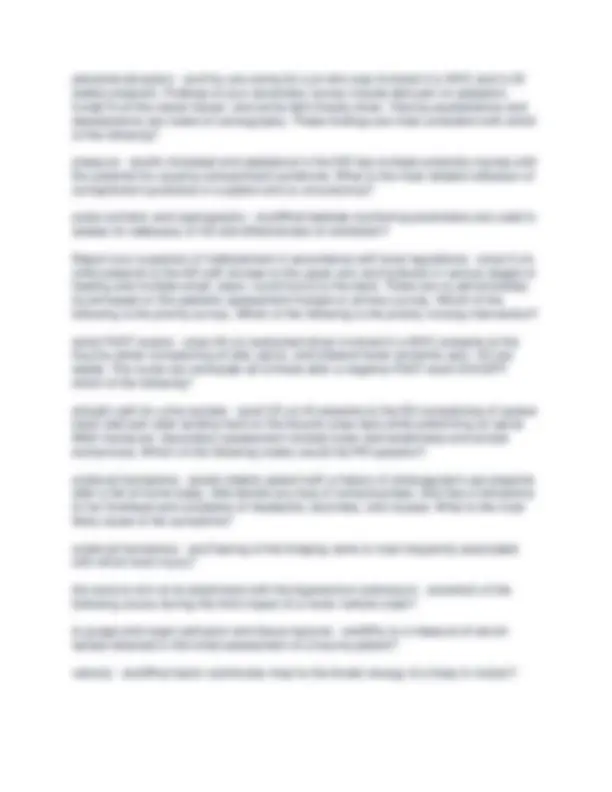


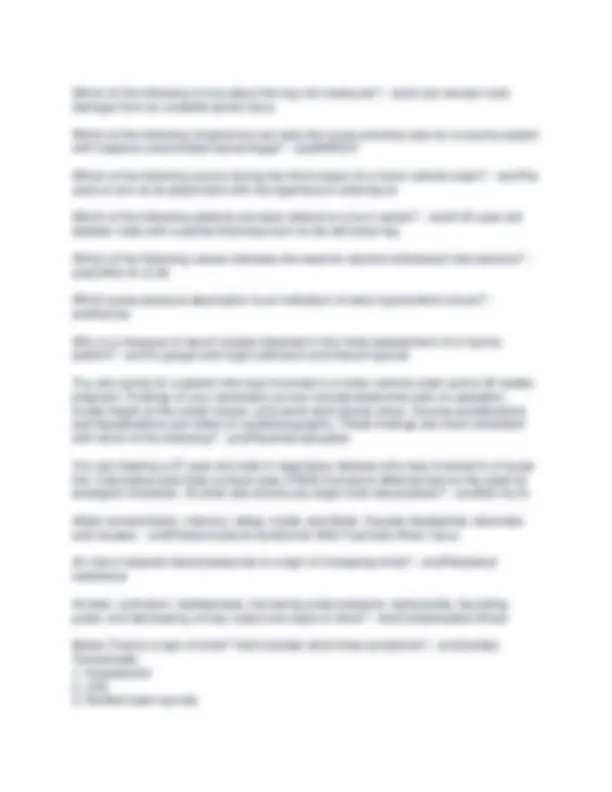


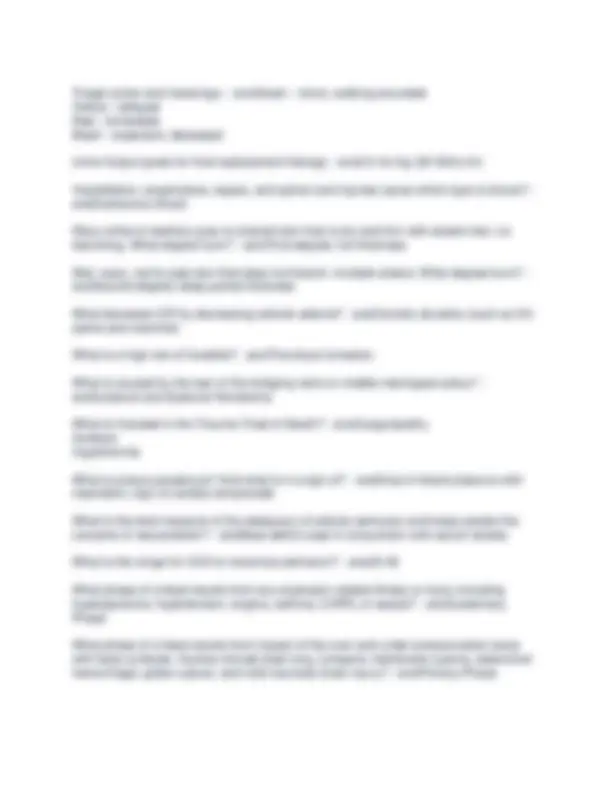
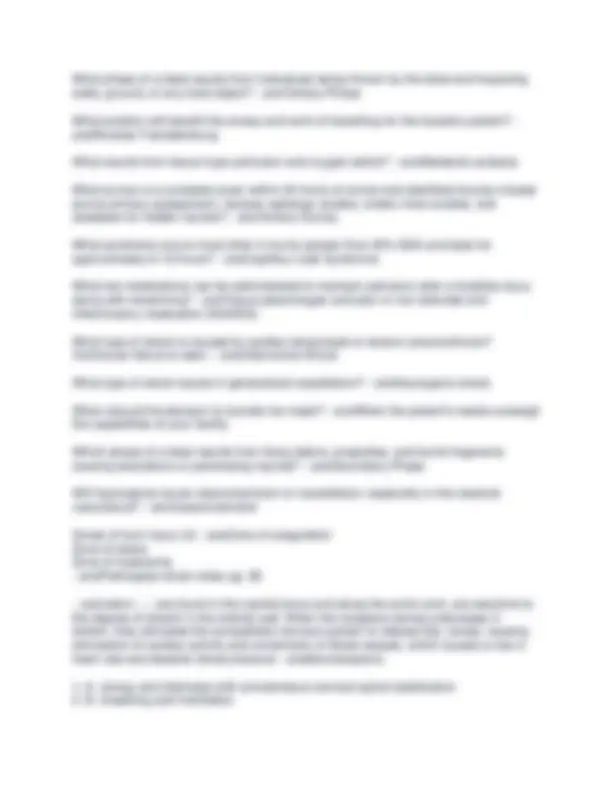
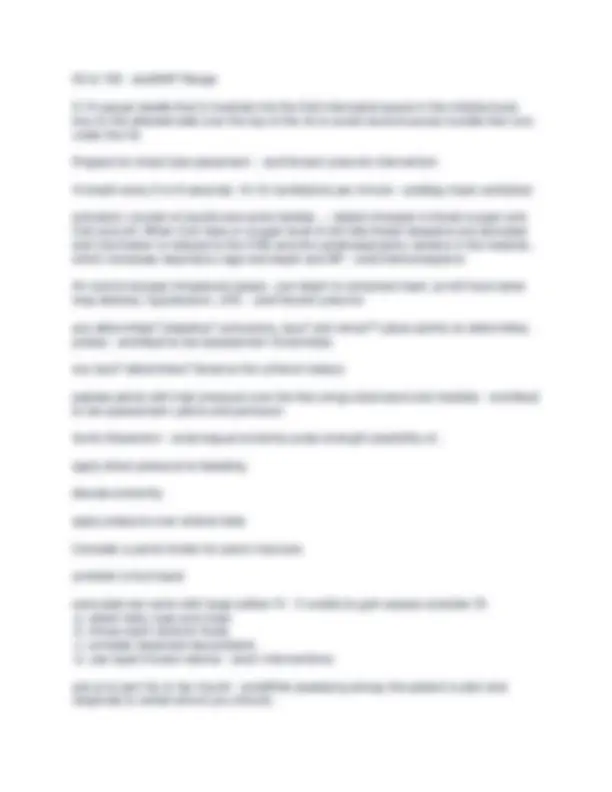

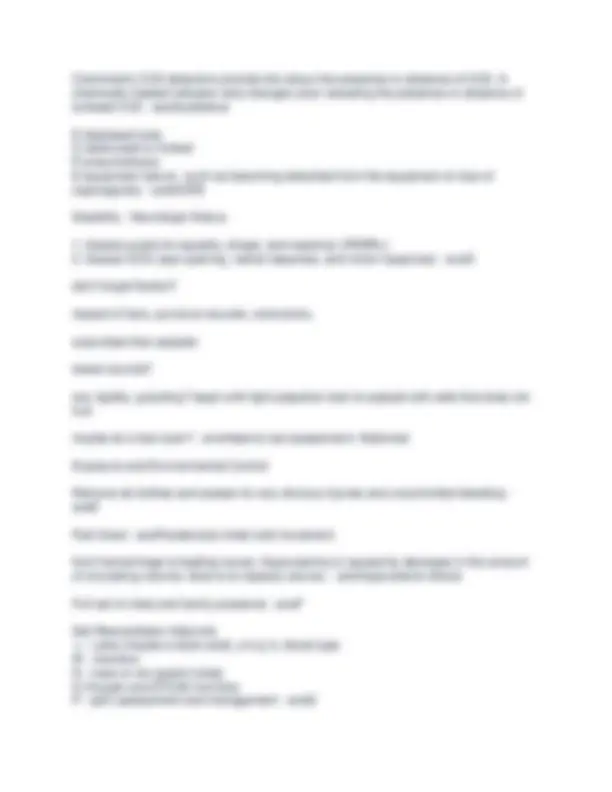






Study with the several resources on Docsity

Earn points by helping other students or get them with a premium plan


Prepare for your exams
Study with the several resources on Docsity

Earn points to download
Earn points by helping other students or get them with a premium plan
Community
Ask the community for help and clear up your study doubts
Discover the best universities in your country according to Docsity users
Free resources
Download our free guides on studying techniques, anxiety management strategies, and thesis advice from Docsity tutors
TNCC test prepA Flashcards.pdf
Typology: Exams
1 / 24

This page cannot be seen from the preview
Don't miss anything!

















500 mL/hr - ansYou are treating a 27 y/o M in respiratory distress who was involved in a house fire. Calculating TBSA burned is deferred due to the need for emergent intubation. At what rate should you begin fluid resuscitation? a 52 y/o diabetic male with a partial thickness burn to the left lower leg - ansWhich of the following patients warrants referral to a burn center? a pertinent medical hx is crucial - ansWhich of the following considerations is the most important when caring for a geriatric trauma pt? acidosis - ansWhich of the following is a component of the trauma triad of death? advanced age - ansWhich of the following is most likely to contribute to inadequate oxygenation and ventilation? after a physical examination if the pt has no radiologic abnormalities on CT - ansEMS arrives with the intoxicated driver of a car involved in a MVC. EMS reports significant damage to the drivers side of the car. The pt is asking to have the cervical collar removed. When it is appropriate to remove the cervical collar? apply splint and elevate above the level of the heart - ansa 37 y/o F has a deformity of the L wrist after a fall. She is reluctant to move her hand due to pain. Which of the following is the most appropriate intervention? bardycardia and absent motor function below the level of injury - ansA pt with a complete spinal cord injury in neurogenic shock will demonstrate hypotension and which other clinical signs? bowel - ansWhich of the following injuries is LEAST likely to be promptly identified? calcium - ansif a pt has received multiple transfusions of banked blood preserved with citrate, which electrolyte is most likely to drop and require supplementation? compensated - ansA trauma pt is restless and repeatedly asking "where am i?" VS upon arrival: BP 110/60, HR96, RR 24. Her skin is cool and dry. Current VS are BP 104/84, HR 108, RR 28. The pt is demonstrating s/sx of which stage of shock?
Complete - ansEMS brings a pt from MVC. VS: BP 90/49, HR 48, RR 12, temp 97.2F (36.2 C). The pt exhibits urinary incontinence and priapism. These assessment findings are most consistent with which of the following types of spinal cord injury? defusings - ansAll of these are considered a critical communication point in trauma care EXCEPT which of the following? dressing removal - ansA patient arrives with a large open chest wound after being assaulted with a machete. Prehospital providers placed a nonporous dressing over the chest wound and taped it on three sides. he is now showing signs of anxiety, restlessness, severe respiratory distress, cyanosis and decreasing blood pressure. Which of the following is the MOST appropriate immediate intervention? dysrhythmias - ansPatients with a crush injury should be monitored for which of the following conditions? elevating the extremity to the level of the heart - ansA pt with a lower extremity fracture complains of severe pain and tightness in his calf, minimally by pain medications. Which of the following is the priority nursing intervention? endotracheal tube - ansThe trauma nurse knows that placing a bariatric patient in a ramped position providers better visualization during the insertion of which device? Expedite transfer to the closest trauma center - ansA 56 y/o M pt involved in a motor vehicle crash is brought to the ED of a rural critical access facility. He complains of neck pain, SOB, and diffuse abd pain. His GCS is 15. His VS: BP 98/71, HR 125, RR 26, SpO2 94% on high-flow O2 via NRB mask. Which of the following is the priority intervention for this patient? fat embolism - ansa pt has been in the ED for several hrs waiting to be admitted. He sustained multiple rib fractures and a femur fracture after a fall. He has been awake, alert, and complaining of leg pain. His wife reported that he suddenly became anxious and confused. Upon reassessment, the pt is restless with respiratory distress and petechiae to his neck. The pt is exhibiting s/sx most commonly associated with which of the following conditions? flucuation in the water seal chamber - ansWhich of the following is an expected finding in a pt with a tube thoracstomy connected to a chest drainage system? globe rupture - ansA 35 y/o M presents with facial trauma after being struck in the face with a baseball. A teardrop-shaped left pupil is noted on exam. What type of injury is suspected? hemoglobin does not readily release O2 for use by the tissues - ansWhat is the effect of hypothermia on the oxyhemoglobin dissociation curve?
placental abruption - ansYou are caring for a pt who was involved in a MVC and is 32 weeks pregnant. Findings of your secondary survey include abd pain on palpation, fundal ht at the costal margin, and some dark bloody show. Varying accelerations and decelerations are noted on cariocgraphy. These findings are most consistent with which of the following? pressure - ansAn intubated and sedated pt in the ED has multiple extremity injuries with the potential for causing compartment syndrome. What is the most reliable indication of compartment syndrome in a patient who is unconscious? pulse oximetry and capnography - ansWhat bedside monitoring parameters are used to assess for adequacy of O2 and effectiveness of ventilation? Report your suspicion of maltreatment in accordance with local regulations - ansa 5 y/o child presents to the ED with bruises to the upper arm and buttocks in various stages of healing and multiple small, clean, round burns to the back. There are no abnormalities found based on the pediatric assessment triangle or primary survey. Which of the following is the priority survey. Which of the following is the priority nursing intervention? serial FAST exams - ansa 49 y/o restrained driver involved in a MVC presents to the trauma center complaining of abd, pelvic, and bilateral lower extremity pain. VS are stable. The nurse can anticipate all of these after a negative FAST exam EXCEPT which of the following? straight cath for urine sample - ansA 20 y/o M presents to the ED complaining of severe lower abd pain after landing hard on the bicycle cross bars while preforming an aerial BMX maneuver. Secondary assessment reveals lower abd tenderness and scrotal ecchymosis. Which of the following orders would the RN question? subdural hematoma - ansAn elderly patient with a history of anticoagulant use presents after a fall at home today. She denies any loss of consciousness. She has a hematoma to her forehead and complains of headache, dizziness, and nausea. What is the most likely cause of her symptoms? subdural hematoma - ansTearing of the bridging veins is most frequently associated with which brain injury? the aorta is torn at its attachment with the ligamentum arteriosum - answhich of the following occurs during the third impact of a motor vehicle crash? to guage end-organ perfusion and tissue hypoxia - ansWhy is a measure of serum lactate obtained in the initial assessment of a trauma patient? velocity - ansWhat factor contributes most to the kinetic energy of a body in motion?
ventilate with a bag mask device - ansAn unresponsive trauma pt has an oropharygeal airway in place, shallow and labored respirations, and dusky skin. The trauma team has administered medications for drug-assisted intubation and attempted intubation but was unsuccessful. What is the most appropriate immediate next step? within 24 hrs of trauma - ansWhen is the tertiary survey completed fora trauma pt? worsening pneumothorax - ansWhich of the following is possible complication of positive-pressure ventilation? A 20-year-old male presents to the ED complaining of severe lower abdominal pain after landing hard on the bicycle cross bars while performing an aerial BMX maneuver. Secondary assessment reveals lower abdominal tenderness and scrotal ecchymosis. Which of the following orders would the nurse question? - ansStraight catheter for urine sample A 35-year-old male presents with facial trauma after being struck in the face with a baseball. A teardrop-shaped left pupil is noted on exam. What type of injury is suspected? - ansGlobe rupture A 36-year-old female has a deformity of the left wrist after a fall. She is reluctant to move her hand due to pain. Which of the following is the most appropriate intervention?
An elderly patient with a history of anticoagulant use presents after a fall at home that day. She denies any loss of consciousness. She has a hematoma to her forehead and complains of headache, dizziness, and nausea. What is the most likely cause of her symptoms? - ansSubdural hematoma An intubated trauma patient is being transferred to a tertiary care center. After moving the patient to the stretcher for transport, a drop in pulse oximetry to 85% is noted. Which of the following is the priority intervention? - ansConfirm endotracheal tube placement An unresponsive trauma patient has an oropharyngeal airway in place, shallow and labored respirations, and dusky skin. The trauma team has administered medications for drug-assisted intubation and attempted intubation but was unsuccessful. What is the most appropriate immediate next step? - ansVentilate with a bag-mask device Caregivers carry a 2-year-old into the emergency department who fell out of a second- story window. The patient is awake and crying with increased work of breathing and pale skin. Which of the following interventions has the highest priority? - ansPadding the upper back while stabilizing the cervical spine During the primary survey of an unconscious patient with multi-system trauma, the nurse notes snoring respirations. Which priority nursing intervention should be performed next? - ansInsert an oropharyngeal airway if there is no gag reflex EMS arrives with the intoxicated driver of a car involved in a motor vehicle crash. EMS reports significant damage to the driver's side of the car. The patient is asking to have the cervical collar removed. When is it appropriate to remove the cervical collar? - ansAfter a physical examination if the patient has no radiologic abnormalities on a computed tomography scan EMS brings a patient who fell while riding his bicycle. Using the American College of Surgeons screening guidelines, which assessment finding would prompt the nurse to prepare the patient for radiologic spine clearance? - ansAlert with no neurological deficits Following a review of recent drills and a real disaster event, a hospital has identified deficiencies and is taking steps to minimize the impact of a future disaster. Which phase of the disaster life cycle does this describe? - ansMitigation If a patient has received multiple transfusions of banked blood preserved with citrate, which electrolyte is most likely to drop and require supplementation? - ansCalcium Patients with a crush injury should be monitored for which of the following conditions? - ansDysrhythmias Tearing of the bridging veins is most frequently associated with which brain injury? - ansSubdural hematoma
The most reassuring finding for a male patient with hip pain after a fall is which of the following? - ansPelvic stability The nurse is caring for a 120 kg male brought in after a warehouse fire and is calculating the patient's fluid resuscitation needs. He has painful red blistering to the entire surface of both upper extremities and superficial burns to the anterior chest. Using the modified Lund and Browder chart to calculate the total body surface area burned, how much intravenous fluid would be administered in the first 8 hours? - ans2280 mL The trauma nurse knows that placing a bariatric patient in a "ramped position" provides better visualization during the insertion of which device? - ansEndotracheal tube What bedside monitoring parameters are used to assess for adequacy of oxygenation and effectiveness of ventilation? - ansPulse oximetry and capnography What factor contributes most to the kinetic energy of a body in motion? - ansVelocity What finding raises suspicion of a complete spinal cord injury? - ansPriapism What is the effect of hypothermia on the oxyhemoglobin dissociation curve? - ansHemoglobin does not readily release oxygen for use by the tissues (Left shift) Which of the following assessment findings differentiates a tension pneumothorax from a simple pneumothorax? - ansHypotension that worsens with inspiration (pulsus paradoxus) Which of the following considerations is most important when caring for a geriatric trauma patient? - ansMedical history Which of the following injuries is LEAST likely to be promptly identified? - ansBowel Which of the following is a component of the trauma triad of death? - ansAcidosis Which of the following is a late sign of increased intracranial pressure? - ansDecreased respiratory effort Which of the following is a possible complication of positive-pressure ventilation? - ansWorsening pneumothorax Which of the following is an expected finding in a patient with a tube thoracostomy connected to a chest drainage system? - ansFluctuation in the water seal chamber Which of the following is NOT considered goal-directed therapy for cardiogenic shock? - ansPericardiocentesis
Benefits of the trauma nursing process - ansSystematic approach to the evaluation of each trauma patient. Identifies life-threatening conditions, determines priorities of care. Burn extends into the fascia and/or muscle. What degree burn? - ansFourth degree; full thickness Cerebral Perfusion Pressure = ______-______ - ansMAP - ICP Contaminated wound, granulation tissue, delayed closure with suture. This is _______ Intention. - ansTertiary Decreased level of consciousness, hypotension, narrowed pulse pressure, tachycardia with weak pulse, tachypnea, and cool, clammy, cyanotic skin are signs of what? - ansDecompensated/Progressive shock Decreased/absent breath sounds ipsilaterally, JVD, hypotension, and tracheal deviation to the contralateral side (late sign) is seen with what? Can lead to what? - ansTension Pneumothorax; PEA Diaphragmatic Tears are seen with what types of injuries? - ansPenetrating injuries between T4-T12, or rapid deceleration causing severe blunt trauma to the torso. Disaster Definition - ansA sudden calamitous event that seriously disrupts the functioning of a community or society and causes human, material, and economic losses that exceed the community's or society's ability to cope using its own resources. Does hypoventilation cause dilation or constriction? Increase or decrease ICP? - ansDilation and increase in ICP due to high CO Dysrhythmia, ischemic changes, and persistent unexplained tachycardia are signs of what? - ansMyocardial contusion from Blunt Cardiac Injury Efficient production of ATP, which maintains cellular metabolic function, is seen with what type of metabolism? - ansAerobic metabolism Epidural hematoma is caused by an arterial or venous bleed? Sx are transient LOC followed by a lucid period. - ansArterial Extremity elevation AT the level of the heart is beneficial for what type of injury? - ansCompartment Syndrome Fluid replacement goals/calculation - ans2mL/kg LR x TBSA% (give 1/2 over first 8 hours (minus transport time) and 1/2 over next 16 hours) Glasgow Coma Score with Mild, Moderate, and Severe TBI - ansMild = 13- 15
Moderate = 9- 12 Severe = 3- 8 Goal value for Cerebral Perfusion Pressure (CPP) - ans> Goal value for ICP - ans< Greatest risk to the patient during interfaculty transfer/transport? - ansLoss of airway and respiratory compromise Hear bowel sounds in chest and Kehr's sign seen with what? - ansTraumatic Diaphragmatic Tear Hemoptysis, ineffective cough, crackles in affected lung, hypoxia/hypercapnia, and alveolar opacities are signs of what? - ansPulmonary Contusion Hyperventilation cause dilation or constriction? - ansConstriction d/t low CO Hyperventilation causes cerebral blood vessels to do what? - ansConstrict Incision with blood clot, edges approximated with suture closer, and results in a fine scar. This is __________ Intention. - ansPrimary Inefficient production of ATP, byproduct is lactic acid, leads to metabolic acidosis, cellular dysfunction leads to cell death with what type of metabolism? - ansAnaerobic metabolism Ipsilateral diminished breath sounds and chest movement is a sign of what? - ansHemothorax Irregular large wound with blood clot, no closure, granulation tissue fills in the wound, results in large scar. This is ________ Intention. - ansSecondary Le Fort Fracture - ansFracture of the maxilla Mitigation - ansA foundation to limit the potential impact of a disaster Moist wound, weeping, red or pink edematous skin that blanches with pressure, some blisters. What degree burn? - ansSecond degree; superficial partial thickness Obtunded/comatose, profound hypotension, bradycardia, dysrhythmias, slow shallow respirations, petechiae/purpura are signs of what? - ansIrreversible shock Open wound on chest wall resulting in sucking sound, decreased breath sounds, chest movement, and hyper-resonance ipsilaterally, subcutaneous emphysema, and tachycardia are signs of what? - ansOpen Pneumothorax
Sluggish reaction of pupils is an early sign of what? - ansIncreasing ICP Soft, dry, red wound with intact skin that blanches with pressure. No blistering or sloughing. What degree burn? - ansFirst degree; superficial Spinal cord injuries at C3-C5 causes loss of what nerves function, resulting in what? - ansPhrenic nerve; paralyzed diaphragm and inability to breath Stages of shock - ans1. Compensatory Shock 2. Decompensatory Shock (progressive, hypotensive) 3. Irreversible Shock Subdural hematoma is caused by tearing of the ______ veins and symptoms usually present within ____ hours of the accident. - ansBridging; 72 Tachycarida, weak pulses, hypotension, cool periphery, delayed cap refill, anxiety and agitation are signs of what type of shock? Seen with what? - ansObstructive Shock; Cardiac Tamponade Tearing chest/back pain, unequal blood pressure and pulses are a sign of what? Caused by a high mechanism of injury. - ansThoracic Aortic Disruption Tertiary care facility, teaching hospital, comprehensive care from resuscitation or rehabilitation, research, injury prevention. - ansLevel 1 Trauma Center The cellular process in which glucose is metabolized into energy without oxygen. Energy is produced in an inefficient manner with many waste products. - ansAnaerobic metabolism The cellular process in which oxygen is used to metabolize glucose. Energy is produced in an efficient manner with minimal waste products. - ansAerobic metabolism Trauma rescucitation and definitive trauma care. Specialty and rehabilitation care may not be as comprehensive, may not conduct research. - ansLevel 2 Trauma Center Treatment for cariogenic shock - ansinotropic support, anti-dysrhythmic medications, treat myocardial infarction or other underlying cause Treatment for distributive shock - ansSupport ventilations, vasopressors, pain management, apply warming methods Treatment for hypovolemic shock - ansTourniquet, 1:1:1 blood products, massive transfusion protocol, TXA, surgical repair Treatment for obstructive shock - anspericardiocentesis, cardiac window, needle decompression, position pregnant patient on L side
Triage colors and meanings: - ansGreen - minor, walking wounded Yellow - delayed Red - immediate Black - expectant, deceased Urine Output goals for fluid replacement therapy - ans0.5 mL/kg (30-50mL/hr) Vasodilation, anaphylaxis, sepsis, and spinal cord injuries cause which type of shock? - ansDistributive Shock Waxy white to leathery gray to charred skin that is dry and firm with absent hair, no blanching. What degree burn? - ansThird degree; full thickness Wet, waxy, red to pale skin that does not blanch, multiple sisters. What degree burn? - ansSecond degree; deep partial thickness What decrease ICP by decreasing cellular edema? - ansOsmotic diuretics (such as 3% saline and mannitol) What is a high risk of frostbite? - ansThrombus formation What is caused by the tear of the bridging veins or middle meningeal artery? - ansSubdural and Epidural Hematoma What is included in the Trauma Triad of Death? - ansCoagulopathy Acidosis Hypothermia What is pulsus paradoxus? And what is it a sign of? - ansDrop in blood pressure with inspiration, sign of cardiac tamponade What is the best measure of the adequacy of cellular perfusion and helps predict the outcome of resuscitation? - ansBase deficit used in conjunction with serum lactate What is the range for CO2 to maximize perfusion? - ans35- 45 What phase of a blast results from any explosion-related illness or injury including hyperglycemia, hypertension, angina, asthma, COPD, or sepsis? - ansQuaternary Phase What phase of a blast results from impact of the over and under pressurization wave with body surfaces. Injuries include blast lung, tympanic membrane rupture, abdominal hemorrhage, globe rupture, and mild traumatic brain injury? - ansPrimary Phase
Before the arrival of the pt - ansWhen should PPE be placed: brachial pulse - ansUnder age of 1 where do you find a pulse Breathing: To assess breathing expose the chest:
Colorimetric CO2 detectors provide info about the presence or absence of CO2. A chemically treated indicator strip changes color revealing the presence or absence of exhaled CO2 - ansQualitative D displaced tube O obstructed or kinked P pneumothorax E equipment failure , such as becoming detached from the equipment or loss of capnopgrahy - ansDOPE Disability - Neurologic Status